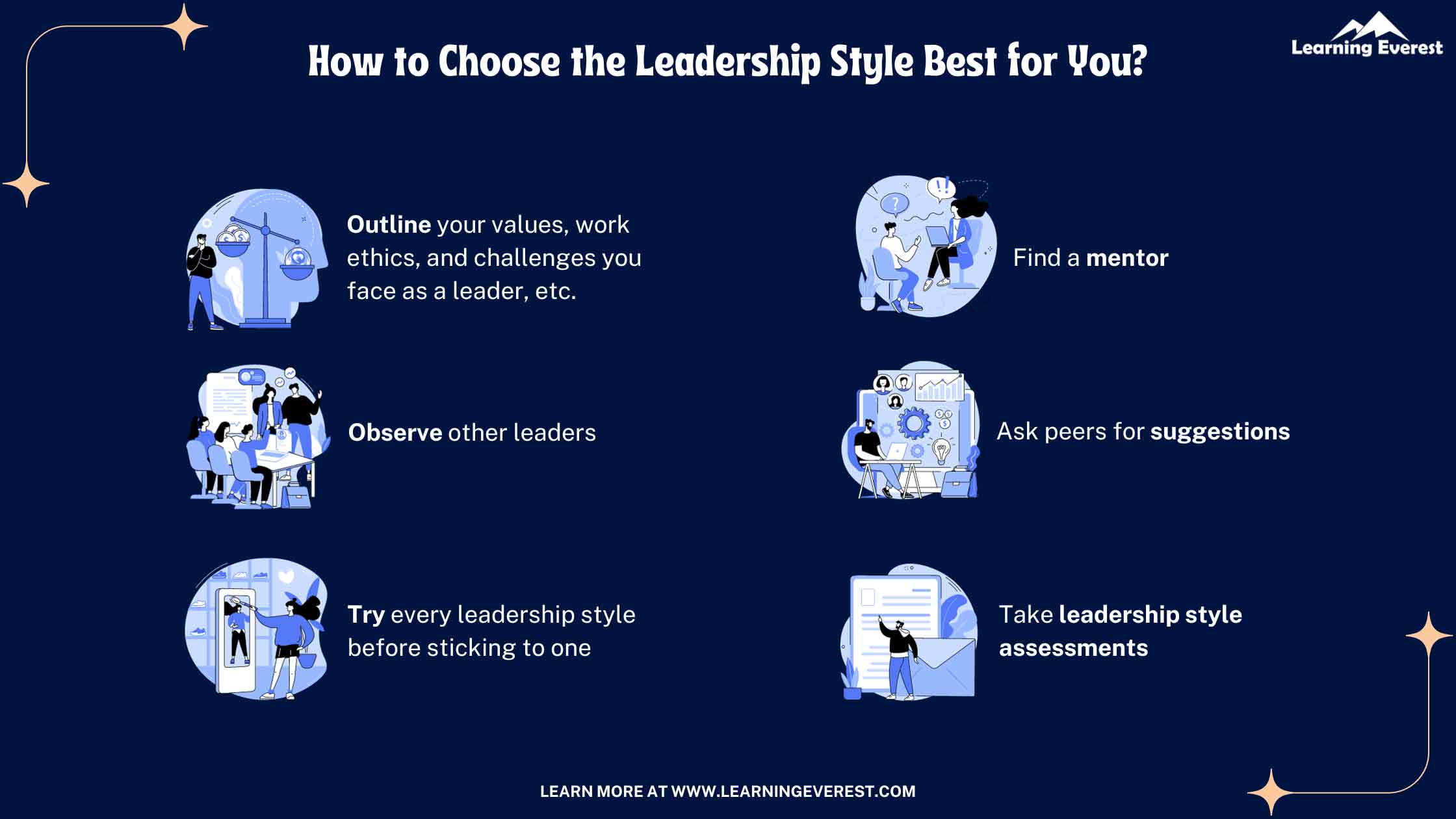What is a Leadership Style?
Leadership style is a way to accomplish the organization’s objective by encouraging employees to work towards the shared goal and focusing on their well-being. Leadership style is the determining factor in how leaders develop strategies, implement plans, and respond to challenges while managing the expectations of stakeholders and the well-being of their team. Recognizing leadership style is imperative for a team to work together and keep growing while embracing changes.
Here are a few reasons why leadership style matters:
- Increases employee engagement
- Improves employee communication and collaboration
- Strengthens the effectiveness of the employees

What is a Leadership Style?
Different Types of Leadership Styles
Democratic Leadership
A democratic leader makes decisions focusing on their team’s opinion and feedback. In more straightforward words, they get everyone involved in the decision-making procedure. This style of leadership requires leaders to be inclusive, utilize good communication skills, and, most importantly, being able to share responsibility.
This leads to a collective effort of a team to identify challenges and develop solutions instead of assigning individual blame. However, this type of leadership is not good in the long run because of disadvantages like losing the leader’s power, arguments, and miscommunication between the team. Democratic leadership is often favored as it helps to build trust with employees. They empower and encourage them to share their ideas on essential matters, demonstrating their value to a team.
Autocratic Leadership
This is the opposite of democratic leadership. The views of team members are not regarded while making any business decision. Instead, leaders wish others to adhere to their decisions, which is not good in the long run. Leaders who adopt this leadership style view themselves as mentors to their followers. Authoritative leadership emphasizes a “follow me” approach. In this way, the leaders chart a course and inspire those around them to follow.
Leaders who show authoritative qualities tend to motivate and inspire those around them. They provide overall guidance and offer their teams direction, feedback, and inspiration. This provides a sense of accomplishment or achievement. But leaders must not try to micromanage. This is a tendency with this leadership style, which can be overpowering for team members and create negative sentiments.
Laissez-faire Leadership
Laissez-faire stands for “let them do”. This leadership style confirms that the decision-making power lies with the team members. This leadership style empowers other team members and holds them responsible for their job. This inspires many team members to put their best foot forward, improving the organization’s efficiency and productivity.
Leaders who adopt this style have to trust and rely on their team members to do their jobs. They do not micromanage or get too engaged in providing feedback or direction. Instead, these leaders give their employees the space to employ their creativity, resources, and knowledge to help them meet their objectives. However, it can also lead to debates among team members and may split or divide a team. It can be challenging for beginners to adapt to this style of leadership to develop an understanding of who is ultimately responsible for consequences.
Strategic leadership
A strategic leadership style is when leaders use their skills and abilities to help team members and organizations achieve long-term objectives. Strategic leaders seek to get the best out of employees or situations.
Transformational Leadership
Transformational leadership is a leadership style that emphasizes change and transformation. They aim to change and improve team members’ and organizations’ functions and capabilities by motivating and encouraging them. Leaders who adopt this style strive to inspire their team to achieve more than they ever thought possible by tapping into their potential. This type of leadership can be highly effective in organizations looking to make significant changes or transformations.
Transactional Leadership
This type of leadership is mainly task-oriented, which means team members who meet their leader’s expectations will be rewarded. This leadership style is based on the action-and-reward concept. With this reward-based system, leaders set clear team goals or tasks. Leaders also clarify how their teams will be rewarded (or punished) for their work. Rewards can take many formats but typically involve financial recompenses, such as pay or a bonus.
Transactional leadership establishes roles and responsibilities for every employee. However, it can lead to diminishing returns if employees are always aware of how much their effort is worth. Therefore, it is important that incentives are consistent with company goals and supported by additional gestures of appreciation.
Coach-Style Leadership
This leadership style focuses on recognizing and promoting a team member’s strengths and shortcomings. A coaching leader creates strategies that emphasize team members’ success. Though this is quite like a strategic and democratic leadership style, the focus here is more on the individual employee.
Bureaucratic Leadership
This type of leadership style sticks to the rules and regulations. For example, the leaders might listen to their team members’ opinions while deciding. The benefits of this type of leadership are that it lowers the risk of favoritism among team members and increases creativity for some employees.
How to Choose the Leadership style best for you?

How to Choose the Leadership Style Best for You
Here are a few ways in which you can choose the best leadership style for you:
- Outline your values, work ethics, and challenges you face as a leader, etc., to understand yourself.
- Observe other leaders to help you determine your leadership style. Watch them handle complex business challenges, clients, stakeholders, etc., to take inspiration from them.
- Try every leadership style before sticking to one.
- Find a mentor to help you find your leadership style.
- Ask peers for suggestions.
- You can also take leadership style assessments to help determine your leadership style.
Infographics
Knowledge Check!
Conclusion
Understanding the types of leadership styles can add much value to the organization and positively impact your team. So, if you want to become a leader and make a difference, pursue an advanced certificate course to equip advanced skills and knowledge. Additionally, these programs help build a strong foundation for becoming an effective leader.






